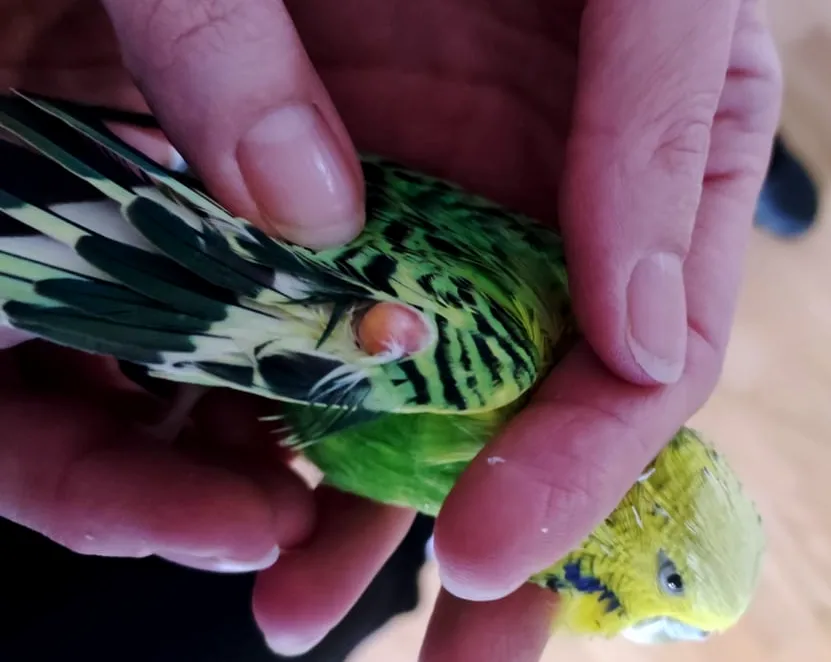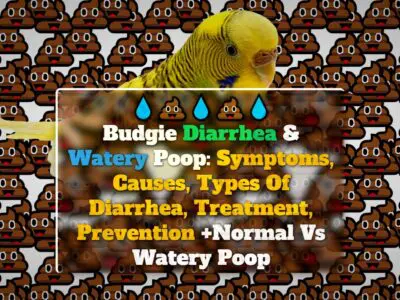One topic of deep interest and concern for many budgie owners is the occurrence of cancer and tumors in these charming creatures.
Can budgies get cancer and tumors? If so, what are the symptoms and causes? How is it treated and diagnosed? What types of cancers and tumors can budgies have? These are all questions that need answering, and it is my goal to provide these answers in this article.
Let’s take a closer look at this important issue and provide you with the knowledge you need to care for your budgie in the best possible way.
Yes, budgies can develop cancer and tumors.
Common symptoms include abnormal growths or lumps, changes in behavior, weight loss, difficulty breathing, changes in droppings, and abnormal feathers.
Causes can range from inherited susceptibility and viral infections to environmental factors and inadequate diet.
Treatment options include surgery, chemotherapy, radiation therapy, palliative care, and hospice care.
Diagnosis involves physical examination, history, and diagnostic tests.
Different types of tumors, such as lipomas, papillomas, sarcomas, ovarian tumors, and testicular tumors, can affect budgies.

What Are The Cancer And Tumor Types In Budgies?
Cancer and tumors are not uncommon in budgies, and they can manifest in different forms.
Here are some of the typical types of cancer and tumors seen in budgies:
Lipomas
Lipomas are benign tumors that originate from fat tissue.
Typically soft and movable under the skin, they are seen in budgies, particularly those on a high-fat diet.
The belly area is a common location for these tumors.
Papillomas
Papillomas are growths that occur on the skin or mucus membranes.
In budgies, these can be found in areas such as the beak, feet, and vent.
Sarcomas
Sarcomas are a type of malignant tumor that arises from mesenchymal cells.
These tumors are typically aggressive and can spread to other parts of the budgie’s body.
Ovarian Tumors
Just as in humans, budgies can develop ovarian tumors.
Female budgies are prone to this type of tumor, which can cause a swollen abdomen and difficulty laying eggs.
Testicular Tumors
Male budgies can develop tumors in the testes.
Signs may include hormonal changes such as aggressive behavior or a change in the color of cere (the fleshy, waxy cap at the base of the beak).
Neoplastic Diseases
Neoplastic diseases involve an abnormal proliferation of cells.
In budgies, this can manifest as different types of cancer and tumors, such as lymphomas, leukemias, and others.
In addition to these, budgies can also be affected by cutaneous and subcutaneous neoplasms, as well as pseudoneoplastic skin conditions.
Cutaneous neoplasms involve the skin, whereas subcutaneous neoplasms occur beneath the skin.
Pseudoneoplastic conditions mimic the appearance and growth of neoplasms but are not true neoplasms.
What Are The Common Symptoms Of Cancer And Tumors In Budgies?
Identifying the symptoms of cancer and tumors in budgies can be challenging, primarily because these birds are adept at hiding their illnesses, a survival instinct that can make early detection difficult.
However, with careful observation, you can recognize some signs that might indicate a problem.
Abnormal Growths Or Lumps
One of the most noticeable symptoms is the appearance of abnormal growths or lumps on the budgie’s body.
These could be soft or hard, mobile or fixed, and may increase in size over time.
Changes In Behavior
Budgies are usually active and chirpy.
If they suddenly become quiet, less active, or show changes in their usual behavior, it could be a sign of discomfort or illness.
Weight Loss
Despite maintaining a healthy diet, if your budgie is losing weight, it could be due to the presence of a tumor.
This could be because the tumor is consuming the nutrients or because the budgie is eating less due to discomfort.
Difficulty Breathing
Tumors, particularly those located in the chest or abdominal area, may cause difficulty in breathing.
A budgie with such a tumor may sit with its beak open, breathing heavily.
Changes In Droppings
Changes in the color, consistency, or frequency of droppings could be indicative of an underlying health issue, including cancer or a tumor.
Distorted Or Abnormal Feathers
The condition of a budgie’s feathers can tell a lot about its health.
Tumors can sometimes cause feathers to become distorted, lose their color, or appear abnormal.
Lethargy And Weakness
A budgie suffering from cancer or a tumor might seem lethargic or weak.
It might spend most of its time at the bottom of the cage or show less interest in flying or playing.
What Are The Common Causes Of Cancer And Tumors In Budgies?
Determining the exact cause of cancer or tumors in budgies can be difficult, but several factors contribute to their development.
Inherited Susceptibility To Tumors
Some budgies may have a genetic predisposition to develop tumors.
If a budgie’s parents or other close relatives have had tumors, it could be more likely to develop them as well.
Viral Infections
Certain viruses are known to cause cancer in birds.
For example, the avian leukosis virus can cause leukemia, and the papilloma virus can cause papillomas.
Contacting With Harmful Substances In The Environment
Exposure to harmful substances such as certain pesticides, cleaning products, or cigarette smoke can contribute to the development of cancer in budgies.
Inadequate Diet And Nutritional Deficiencies
A diet deficient in essential nutrients or high in fat can lead to health issues, including tumors.
For example, a high-fat diet can lead to lipomas.
Physical Trauma And Wounds
Sometimes, repeated physical trauma or untreated wounds can lead to the development of tumors.
How To Treat Cancer And Tumors In Budgies?
When a budgie is diagnosed with cancer or a tumor, the treatment options depend on several factors including the type of cancer or tumor, its location, and the overall health of the budgie.
Tumor Removal Through Surgery
Surgery is often the first line of treatment for tumors in budgies.
The goal is to remove the tumor and any affected tissue.
However, not all tumors can be removed, especially if they are in a difficult location or if the budgie is not in good health.
Conducting Chemotherapy Sessions
Chemotherapy, the use of drugs to kill cancer cells, is sometimes used to treat cancer in budgies.
However, it’s important to note that chemotherapy can have side effects, such as loss of appetite and nausea.
Administering Radiation Therapy
In certain cases, radiation therapy might be an option.
This involves using high-energy rays to kill cancer cells.
As with chemotherapy, there can be side effects, including skin irritation and temporary hair loss.
Implementing Palliative Care To Ease Symptoms
Palliative care is aimed at making the budgie comfortable and alleviating symptoms rather than treating the tumor itself.
This can include pain relief, nutritional support, and other supportive care.
Providing Hospice Care For End-of-life Comfort
In some cases, when treatment is not possible or if it is not improving the budgie’s quality of life, the focus might shift to providing hospice care, ensuring the bird’s comfort in the final stages of its life.
How Are Cancer And Tumors Diagnosed In Budgies?
Cancer and tumors in budgies are diagnosed using a combination of physical examination, history, and diagnostic tests.
The veterinarian might feel for lumps or look for other physical signs of illness.
Diagnostic tests can include blood tests, X-rays, ultrasound, or even a biopsy, where a small piece of tissue is removed and examined under a microscope.
Early detection is crucial for successful treatment, emphasizing the importance of regular veterinary check-ups.
Attending To Budgies Affected By Tumors
Caring for a budgie affected by a tumor involves a multi-faceted approach.
Here are some strategies that may be beneficial:
Offering Nurturing Assistance
As a pet owner, you play a critical role in your budgie’s wellbeing.
Offering tender, loving care, such as providing a comfortable environment, minimizing stress, and spending quality time, can make a significant difference.
Altering The Bird’s Diet
Diet is a critical aspect of a budgie’s health.
Depending on the illness, your vet may recommend dietary changes.
This could involve incorporating more fresh fruits and vegetables or reducing fat content.
Vigilantly Observing For Alterations In Tumor Size Or Behavior
Regularly monitoring the size of the tumor and the behavior of your budgie is essential.
Any sudden changes should be reported to the vet immediately.
Significance Of Routine Veterinary Check-ups
Routine vet check-ups can help detect issues early and ensure that your budgie gets the necessary care and treatment promptly.
FAQs
How Long Can A Budgie Live With A Tumor?
The life expectancy of a budgie with a tumor can vary greatly depending on the type and location of the tumor, the budgie’s overall health, and the care and treatment it receives.
When To Consider Euthanasia For Budgies With Cancer Or Tumors?
Euthanasia is a difficult and personal decision that should be discussed with a trusted veterinarian.
It may be considered when a budgie’s quality of life is severely compromised, and there is little chance of improvement.
Why Are Budgies Prone To Tumors?
While there is no definitive answer, it’s believed that a combination of genetic factors, environmental exposure, diet, and age can contribute to a budgie’s susceptibility to tumors.
Why Are Larger Budgies Like English Budgies More Prone To Cancer And Tumors?
Larger budgies, such as English budgies, are often associated with a higher incidence of certain diseases, including cancer and tumors.
This vulnerability can be attributed to the breeding practices that have been focused on selecting larger individuals over generations.
The continuous selection for size in English budgies may have inadvertently led to a higher prevalence of genetic factors that predispose them to certain health conditions, including cancer and tumors.
However, it’s important to note that additional research is needed to fully understand the relationship between budgie size and cancer susceptibility.
Proper care, regular check-ups, and a healthy lifestyle can help mitigate potential health risks for all budgies, regardless of their size or breed.
Are All Tumors Cancerous?
No, not all tumors are cancerous.
Tumors can be benign (non-cancerous) or malignant (cancerous).
Benign tumors grow locally and do not spread, while malignant tumors can invade nearby tissues and spread to other parts of the body.
Are All Lumps Considered Tumors?
No, not all lumps are tumors.
Lumps can also be caused by abscesses, cysts, or other conditions.
Any unusual lump should be examined by a vet to determine its cause.
Can Budgies Get Multiple Tumors Simultaneously?
Yes, budgies can develop multiple tumors simultaneously.
The likelihood of multiple tumors depends on various factors, including genetic predisposition, exposure to risk factors, and overall health.
Is Cancer More Common In Older Budgies?
Cancer can occur in budgies of any age, but it’s more commonly observed in older birds.
As budgies age, their risk of developing tumors increases.
Can Budgies Transmit Cancer Or Tumors To Other Birds Or Pets?
Cancer and tumors are not typically transmissible between budgies or to other birds or pets.
However, certain viral infections associated with tumors, such as avian leukosis, can be transmitted to other budgies.
It’s important to maintain proper hygiene and prevent direct contact between infected and healthy birds to minimize the risk of transmission.
Sources:

![Budgies & Worms [+Symptoms, Treatment, Worming]](https://www.petiska.com/wp-content/uploads/2022/05/budgies-worms-symptoms-treatment-worming-1652037136-400x300.jpg)
![Budgie Zinc Poisoning [Symptoms, Causes, Treatment]](https://www.petiska.com/wp-content/uploads/2022/06/budgie-zinc-poisoning-symptoms-causes-treatment-1654089731-400x300.jpg)